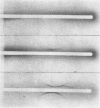Abstract
Beta-lactamase-containing fractions have been isolated from Myobacterium tuberculosis strain R1Rv and M. smegmatis strains NCTC 8158 and T-64. Antisera raised in rabbits to these fractions demonstrated no cross-reactivity with a commercial Bacillus cereus beta-lactamase. Antiserum to either strain of M. smegmatis revealed no cross-reactivity with M. tuberculosis R1Rv, one specificity in common with the other M. smegmatis strain, and two specificities unique to the immunizing fractions. Further characterization of the common specificity was not possible, but beta-lactamase activity was related to the strain-specific precipitin lines in each case. These studies demonstrate the feasibility of isolating beta-lactamase enzyme fractions that may prove useful in the classification and diagnosis of mycobacteria.
Full text
PDF




Images in this article
Selected References
These references are in PubMed. This may not be the complete list of references from this article.
- Alter H. J., Holland P. V., Purcell R. H. Counterelectrophoresis for detection of hepatitis--associated antigen: methodology and comparison with gel diffusion and complement fixation. J Lab Clin Med. 1971 Jun;77(6):1000–1010. [PubMed] [Google Scholar]
- BOYDEN S. V., SORKIN E. A study of antigens active in the tannic acid hemagglutination test present in filtrates of culture of Mycobacterium tuberculosis. J Immunol. 1955 Jul;75(1):15–21. [PubMed] [Google Scholar]
- CROWLE A. J. Immunizing constituents of the tubercle bacillus. Bacteriol Rev. 1958 Sep;22(3):183–203. doi: 10.1128/br.22.3.183-203.1958. [DOI] [PMC free article] [PubMed] [Google Scholar]
- Castelnuovo G., Morellini M. The antigens of mycobacteria and their identification by immunoelectrophoretic analysis. Am Rev Respir Dis. 1965 Dec;92(6):29–33. doi: 10.1164/arrd.1965.92.6P2.29. [DOI] [PubMed] [Google Scholar]
- Citri N., Pollock M. R. The biochemistry and function of beta-lactamase (penicillinase). Adv Enzymol Relat Areas Mol Biol. 1966;28:237–323. doi: 10.1002/9780470122730.ch4. [DOI] [PubMed] [Google Scholar]
- Dufour A. P., Knight R. A., Harris H. W. Mycobacterial penicillinase activity. Am Rev Respir Dis. 1966 Dec;94(6):965–968. doi: 10.1164/arrd.1966.94.6.965. [DOI] [PubMed] [Google Scholar]
- KASIK J. E. THE NATURE OF MYCOBACTERIAL PENICILLINASE. Am Rev Respir Dis. 1965 Jan;91:117–119. doi: 10.1164/arrd.1965.91.1.117. [DOI] [PubMed] [Google Scholar]
- Kasik J. E., Peacham L. Properties of beta-lactamases produced by three species of mycobacteria. Biochem J. 1968 May;107(5):675–682. doi: 10.1042/bj1070675. [DOI] [PMC free article] [PubMed] [Google Scholar]
- Kniker W. T. The use of ion-exchange chromatography for mycobacterial antigen isolation. Am Rev Respir Dis. 1965 Dec;92(6):19–28. doi: 10.1164/arrd.1965.92.6P2.19. [DOI] [PubMed] [Google Scholar]
- Lind A. Immunologic analysis of mycobacterial antigens. Am Rev Respir Dis. 1965 Dec;92(6):54–62. doi: 10.1164/arrd.1965.92.6P2.54. [DOI] [PubMed] [Google Scholar]
- MANKIEWICZ E. Agar diffusion precipitation and complement fixation tests applied to the study of the antigenic relationships between chromogenic acid-fast bacteria and Mycobacterium tuberculosis. Can J Microbiol. 1958 Dec;4(6):565–570. doi: 10.1139/m58-063. [DOI] [PubMed] [Google Scholar]
- Minden P., Farr R. S. Binding between components of the tubercle bacillus and humoral antibodies. J Exp Med. 1969 Nov 1;130(5):931–954. doi: 10.1084/jem.130.5.931. [DOI] [PMC free article] [PubMed] [Google Scholar]
- Mishra R. K., Kasik J. E. The mechanism of mycobacterial resistance to penicillins and cephalosporins. Int Z Klin Pharmakol Ther Toxikol. 1970 Jan;3(1):73–77. [PubMed] [Google Scholar]
- PARLETT R. C., YOUMANS G. P. Antigenic relationships between ninety-eight strains of mycobacteria using gel-diffusion precipitation techniques. Am Rev Tuberc. 1958 Mar;77(3):450–461. doi: 10.1164/artpd.1958.77.3.450. [DOI] [PubMed] [Google Scholar]
- PERRET C. J. Iodometric assay of penicillinase. Nature. 1954 Nov 27;174(4439):1012–1013. doi: 10.1038/1741012a0. [DOI] [PubMed] [Google Scholar]
- POLLOCK M. R. Penicillinase-antipenicillinase. Ann N Y Acad Sci. 1963 May 8;103:989–1005. doi: 10.1111/j.1749-6632.1963.tb53750.x. [DOI] [PubMed] [Google Scholar]
- SOLTYS M. A. The effect of penicillin on Mycobacteria in vitro and in vivo. Tubercle. 1952 Apr;33(4):120–125. doi: 10.1016/s0041-3879(52)80054-6. [DOI] [PubMed] [Google Scholar]
- TACKING R. Immunization experiments with penicillinase. Acta Pathol Microbiol Scand. 1955;36(1):61–65. [PubMed] [Google Scholar]
- VEITH D., WHITE A. G. SOME OBSERVATIONS ON STAPHYLOCOCCAL PENICILLINASE. Proc Soc Exp Biol Med. 1965 Jan;118:277–283. doi: 10.3181/00379727-118-29819. [DOI] [PubMed] [Google Scholar]
- Woodruff H. B., Foster J. W. Microbiological Aspects of Penicillin: VII. Bacterial Penicillinase. J Bacteriol. 1945 Jan;49(1):7–17. doi: 10.1128/jb.49.1.7-17.1945. [DOI] [PMC free article] [PubMed] [Google Scholar]








